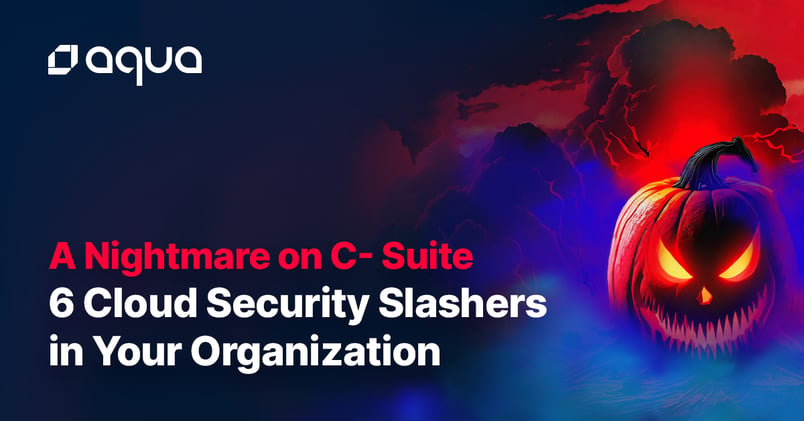In honor of October, known as National Cyber Security Month and more notably as today is Halloween, we thought we would have some fun with our blog and give you a tale of cyber security terror!
Deep within the cryptic corners of a cluttered server room, the fate of your business teeters on a tantalizing tightrope, subject to abrupt upheaval. In this dimly lit dungeon of the digital realm, a brand of horror exists that sends shivers down the spines of corporate entities, making server racks rattle in terror.
Our tale is so harrowing that even the most intrepid Chief Information Security Officers (CISOs) within corporate giants are tormented by this nightmare. Instead of a scar-faced madman with a glove of knives or a chainsaw-wielding lunatic, it is the monstrous entities lurking within their cloud environments that keep them awake at night, wielding wicked Wi-Fi wands and malevolent megabytes.
Welcome to "A Nightmare on C-Suite: 6 Cloud Security Slashers in Your Organization."
The Phantom Data Breach
As the moon ascends over the digital expanse of your enterprise, a ghastly data breach materializes like a phantom, an eerie apparition haunting the system. Your sensitive information, once safeguarded, now drifts through environments, and evades firewalls, rendering your organization defenseless.
This cloud security nightmare, a ghostly presence lurking in the dim recesses, mirrors the spectral presence haunting your enterprise's stability. Just as this otherworldly entity resides elsewhere, the data in cloud native workloads also resides elsewhere in the cloud and can be accessed outside the applications’ main processes. A data breach can unleash regulatory fines, legal entanglements, and erode customer trust, casting a chilling effect across all industries.
No need for iron pokers or salt to fend off these apparitions; instead, fortify your cloud accounts and resources with robust access controls. Cloud native applications are often not fully connected to the organization’s intrusion detection and incident response, making discovery and containment the true terror for the CISO in the quest to secure cloud native workloads, a realm shrouded in newness and variability. The log4j incident epitomizes this, where CISOs found themselves unaware of their exposure, highlighting the novelty and complexity of cloud native security.
Not being fully connected to the organization’s intrusion detection and incident response, additionally make discovery and containment difficult to reveal the hidden spectral threats prowling within the cosmic domain. Illuminate these eerie corners with potent observability tools, runtime security with eBPF, SIEM integration, and drift prevention.
The Zombie Malware Apocalypse
Amidst the cloud's confines, malware meanders much like an immortal, insidious phantom—ever resurrecting from the digital abyss. Despite the formidable fortifications erected, these spectral strains can surge back with a tenacity mirroring the undead from "The Walking Dead." Just as these tireless terrors invade screens, malware infiltrates systems, wreaking havoc on an enterprise's economic stability.
Malware malevolence possesses the power to disrupt operations, corrupt transactions, and usher in financial fright. While financial firms stand as favored targets for cyber assailants, any business could succumb to this digital dread. A malware outbreak can be inserted in multiple places: supply chain, devops pipeline, nodes, workloads and swiftly morphs a digital domain into a catastrophic apocalypse.
Strengthening defenses against these cloud native calamities is critical. Deploying tools like behavioral detection, eBPF (extended Berkeley Packet Filter), or runtime strategies resembles wielding the right weapons against these advanced, haunting malware strains. In the realm of cloud-specific concerns, the lurking of malware within your environments demands dedicated vigilance.
CISOs grapple with the urgency of these sophisticated safeguards, navigating ever-evolving threats in cloud native environments. Detecting and deterring assaults targeting cloud native systems, or artfully dodging traditional security tools constitutes a crucial cornerstone. Bad application design with persistent workload state (e.g., lift and shift monolithic VMs to containers) makes it harder to clean malware without disrupting the application.
As these threats persist and mutate within the cloudscape, keeping ahead with adaptable measures stands as the linchpin for CISOs. Arm your arsenal, perhaps not with barbed wire but with knowledge, and empower your team with microservices-oriented design where the infected workload can be deleted without service disruption to thwart the malicious malware undead before they feast on your precious data brains!
The Invisible Insider Threat
In the realm of cloud security, there exists an unseen menace: the insider threat, akin to the invisible antagonist in "The Invisible Man." Like the concealed villain, detecting insider threats can be a formidable challenge until significant damage has been done.
Cloud, Kubernetes, containers, and functions require management spanning thousands and thousands of resources. It’s easy to lose track of them: both in removing old resources and accounting for new resources. Disgruntled employees or malicious insiders possessing access can tamper with data, conduct unauthorized transactions, or leak sensitive information, leading to significant and widespread financial consequences.
Moreover, combating insider threats involves more than just monitoring as from the inside, attackers can hide malicious or resource-stealing workloads in remote corners of the cloud, or among large scale array of authorized workloads
Addressing this elusive threat requires a zero-trust approach, acceptance gates for authorized and compliant resources/workloads, continual monitoring and the application of user behavior analytics. Much like shining a light into the obscure recesses of a haunted house, CISOs deploy sophisticated tools to identify unusual behavior and highlight potential threats. It's an ongoing battle to fend off this spectral presence.
The Poltergeist of Shadow IT
Within the eerie expanse of cloud security, Shadow IT slinks like a sinister specter, a stealthy force stirring chaos and commotion within corporate confines. Cloud providers keep offering new services and capabilities. Application teams are eager to use them, often without advice or approval from security. They eagerly embrace unauthorized cloud applications, entangling the enterprise in security snares, fostering financial fragility.
Much like a mischievous poltergeist, Shadow IT mysteriously maneuvers sensitive data beyond the bulwarks of security, leaving it vulnerable to breaches. These haunting breaches haunt diverse sectors, heaping hefty financial harm.
To exorcise these unauthorized IT apparitions, erect cloud-native protocols, proffering precise parameters. Prune the privileged users and promptly purge access that pandemonium-peddling phantoms exploit before they provoke pernicious pitfalls. In this cloudy realm rife with malware and menacing zero-day menaces, fortify defenses against these fiendish foes. Only then can one shield against the stealthy, spine-chilling shadows that lurk within the digital domain.
The Frankenstein's Monster of Misconfigured Clouds
Within the realm of enterprise empowerment, cloud infrastructure stands as a potent force. Yet, this very power can transmute into a fearsome fiend when mishandled. Cloud defaults still favor usability over security, misconfigured clouds resemble the contemporary embodiment of Frankenstein's monstrous creation—cobbled together haphazardly, animated with unforeseeable repercussions.
Huge volumes of misconfigurations can be overwhelming. A cloud misconfiguration in the wrong place can make a small intrusion into a big one. These misconfigurations render your systems vulnerable, akin to leaving gaping entryways for cyber predators. The ensuing financial wreckage can be catastrophic, casting a harrowing shadow over enterprises spanning diverse industries. The problem is how to prioritize the “right” misconfigurations to fix.
To mend these misconfigurations within cloud-native domains and tame this unruly beast, a deliberate approach must be embraced. Implementing rigorous configuration management practices akin to conducting surgery on the cloud's fabric becomes imperative. Continuous monitoring and automated tools, such as Cloud Security Posture Management (CSPM), Infrastructure as Code (IaC) and Configuration as Code (CaC), act as shields against this monstrous mayhem.
Embracing a robust strategy, companies can fortify their cloud environments, thwarting the lurking horrors of misconfigurations. Vigilance and adherence to best practices become the torchlight guiding enterprises through this dark, cloud-infested labyrinth. Only by taming this modern monster can enterprises harness the true potential and power of the cloud without succumbing to its ominous perils.
The Specter of Compliance Violations
In the perilous landscape of cloud security, our ultimate dread emerges as the ghastly ghost of compliance violations. While a haunted house evades the bounds of rules, organizations must abide by stringent compliance requirements in the cloud. Measuring compliance of an entire application is now spread across data points coming from devops, cloud config, images, and workloads. Violations unleash colossal fines and tarnish an organization's standing.
CISOs confront this chilling specter by enacting robust compliance monitoring and meticulous reporting mechanisms. They meticulously document security measures and routinely scrutinize their cloud realm to ensure alignment with industry standards and regulations. It's an exacting endeavor resembling the scrutiny of supernatural events, maintaining vigilance over the haunted house.
The nightmares of compliance violations unfurl financial horrors akin to Wall Street calamities, with regulators levying penalties and shareholders losing faith, akin to the endless terrors of "Nightmare on Elm Street." Moreover, substantial time is spent painstakingly crafting compliance reports across diverse environments, mirroring the effort of chronicling these unsettling tales of non-compliance.
As CISOs navigate this eerie landscape, ensuring adherence to regulations across their spectral cloud domains becomes a critical saga. Staving off these compliance ghouls demands unrelenting attention and dedication to upholding the rules in this nightmarish cloud expanse.
A Cautionary Conclusion for Our Courageous CISOs
In the domain of cloud native operations, CISOs grapple with a myriad of chilling threats capable of unsettling their enterprise's financial balance. These haunting specters of cloud security aren't limited to specific industries; instead, they loom over all enterprises, irrespective of their field or domain within the cloud native ecosystem.
So, in this Halloween season, a thought should be spared for you valiant CISOs, locked in combat with these cloud security phantoms to safeguard our digital world. Armed with the right tools, strategies, and a touch of levity, you can face even the most daunting cybersecurity challenges to emerge triumphant and not locked in the dungeon. In the realm of cybersecurity, there is no room for fear—only readiness and resilience in the face of the unknown.
But take heart, brave CISOs, for just as heroes rise to confront their fears in classic horror films, you too can stand up to these cloud security nightmares.
Wishing you a spine-tingling Halloween and safe sojourns in the cloud!
By implementing robust security measures, remaining vigilant, and adapting to the ever-evolving threat landscape, you too can safeguard your enterprise's well-being and banish the specters of cloud security nightmares. To learn more about the monsters hiding in your cloud environments and a tool to help you to battle these nightmares reach out, see a demo of the Aqua CNAPP platform

